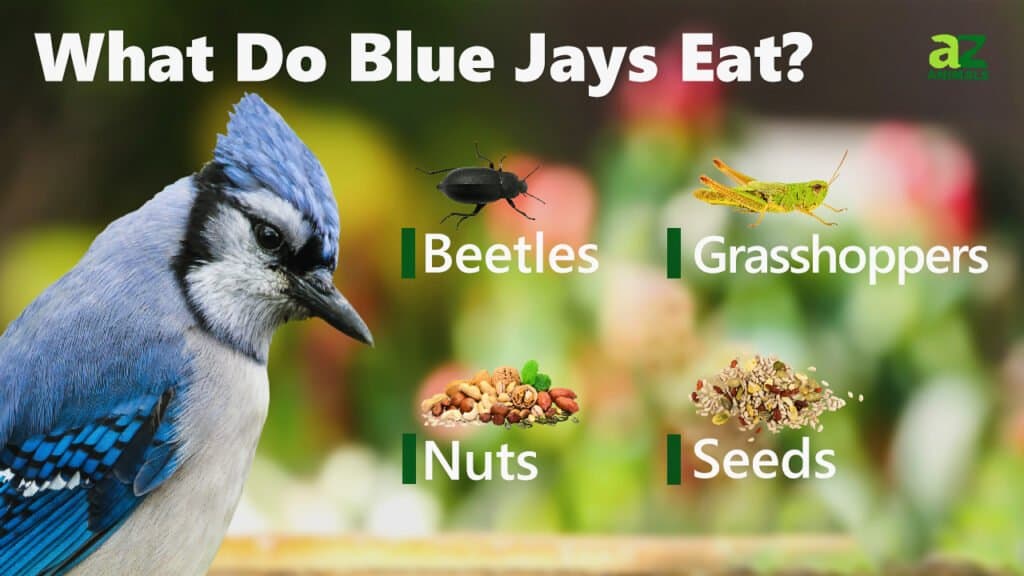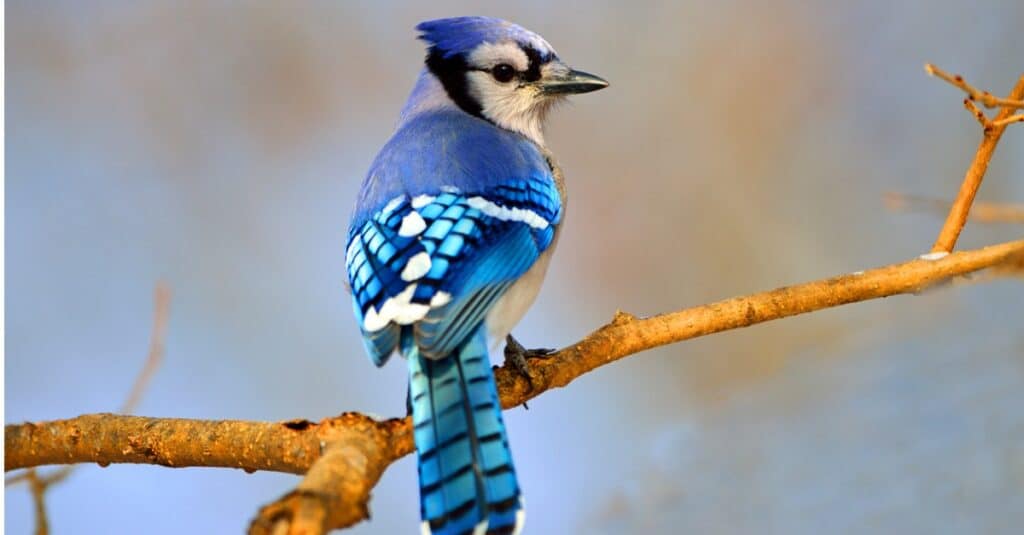What Does the Blue Jay Eat?

- Unlikely cousins to the crow, they share its intelligence and ability to use tools.
- They are also not above engaging in petty theft and have divised a rather clever means of divesting other birds of their dinner.
In the scientific jargon, the blue jay is known as a generalist; it has a very wide and diverse diet, consuming almost anything it finds. Altogether, scientists have estimated that around 75% of its diet — and an even higher percentage in the winter — consists of plant matter. Fruits, grains, corn, seeds, and nuts constitute the bulk of its diet. This provides the bird with most of the necessary nutrients and calories.
The most important source of meat is insects: beetles, grasshoppers, and caterpillars are all common staples. In order to supplement its diet with more meat, the blue jay will sometimes hunt rodents, frogs, spiders, and snails if the opportunity ever arises. It also sometimes raids bird nests to consume eggs and young hatchlings. However, the blue jay isn’t a great hunter, and it prefers to forage or scavenge for easy food. If it finds dead carrion killed by an accident or another carnivore, then it has no qualms against eating that as well. The exact composition of the diet will change slightly based on its location and the time of year.
How Does the Blue Jay Eat?
The evolution of the blue jay testifies to its plant-heavy diet. Whereas tough foods would deter other animals, the blue jay is hardly daunted. While holding the nut with its feet, the bird will pry open the outer shell with its long and sharp bill. The blue jay will rarely leave anything to waste. Often, when it has left over food after a meal, it will keep the remaining bits temporarily stored in its expansive throat pouch. The blue jay will then bury (or “cache”) the left over food throughout its territory for later use; trees, rocks, and other crevices provide ample storage space.
Caching is a very common strategy throughout the animal kingdom. Chipmunks and squirrels also store their food in this manner. To what extent blue jays cache food depends on the individual. However, it is thought to play a very important ecological role in the environment. When the blue jay forgets where it has hidden its food (or simply never comes back to it), the seed have the opportunity grow into a full plant.
As a member of the crow family, the blue jay is highly intelligent and resourceful. What it can’t earn from brute strength it sometimes makes up with tricks and deceit. The blue jay has the ability to steal food from other birds by frightening them with a sudden and loud call. When the unsuspecting target drops its meal, the blue jay will be there to swoop in and take it.
In captivity, there has been at least one documented instance of a blue jay using a tool to obtain food. The scientific study showed the bird manipulating a strip of newspaper to rake in food pellets from beyond the confines of its cage. It’s not entirely clear how much tool use is deployed in the wild though.
Where Does the Blue Jay Forage?
Blue jays generally have a defined territory in which they can forage or hunt during the daytime. Beech and oak trees are among their favorite foraging and nesting sites. They also like to pick through shrubs and bushes for any little food morsels they can find. The evidence suggests that they do migrate short distances during the winter to find better food sources.
In the middle of the year a breeding pair maintains a very strict territory and guards it aggressively. Both the mother and father will feed their voracious nestlings for the first few weeks after hatching until they’re ready to leave the nest and forage for themselves. The young birds generally stick around and forage with the family, but they must disperse by winter time to avoid competition for scarce resources.
How Do You Attract Blue Jays to Your Feeder?

©iStock.com/BrianEKushner
The best way to attract them is to place a ground or pole-mounted feeder ideally next to a tree or shrub. The blue jay enjoys peanuts, sunflowers, mealworms, corn, and acorns. However, this is a very territorial bird and will sometimes monopolize the bird feeder for itself.
A handy solution is getting a bird feeder which is too small for blue jays, so smaller birds can eat to their hearts’ content.
But visiting blue jays don’t have to be left out either or leave with empty stomachs: a feeder stocked with some of their favorite food (peanuts and sunflower seeds) will do quite nicely for them. A win-win situation in which you’d be able to nourish every avian that visits your garden – and prevent any blue jays from bullying smaller birds.
Blue jays do enjoy birdbaths to groom their feathers, but they tend not to use manmade nests.
A Complete List of the Top 10 Foods the Blue Jay Eats
Here is a list of the top 10 foods favored by the blue jay. Some of these foods are grouped into wider categories, because the blue jay will feed on many species within that group, not just a single one. Though it may not look like it, the diet is heavily tilted toward plant-based foods.
- Nuts
- Seeds
- Grains
- Fruits
- Insects
- Spiders
- Snails
- Rodents
- Frogs
- Eggs
Up Next…
Keep reading these posts for more incredible information about key animal facts.
- 10 Incredible Blue Jay Facts: They’re gifted with mimicry which they can put to benevolent or mischievous use. And there’s much more to these birds which aren’t really blue. And you can read all about them right here.
- Bluebird vs Bluejay: 5 Main Differences Explained: One is easy going and the other somewhat belligerent. One is long-lived while the other isn’t that lucky. Find out who is who in this guide.
- 5 Types of Birds That Are Blue: They belong to different species and come in all shapes and sizes. Discover 5 birds which have that royal color in common.
The photo featured at the top of this post is © iStock.com/BrianEKushner
Thank you for reading! Have some feedback for us? Contact the AZ Animals editorial team.






